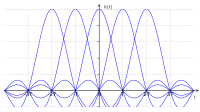
Photo from wikipedia
This paper investigates the achievable uplink spectral efficiency (SE) of a massive multi-input multi-output (MIMO) system with a mixed analog-to-digital converter (ADC) receiver architecture, in which some antennas are equipped… Click to show full abstract
This paper investigates the achievable uplink spectral efficiency (SE) of a massive multi-input multi-output (MIMO) system with a mixed analog-to-digital converter (ADC) receiver architecture, in which some antennas are equipped with full-resolution ADCs while others are deployed with low-resolution ADCs. We derive the theoretical results and corresponding approximate expressions of the achievable SE in multi-cell systems with maximum ratio combining (MRC) detector and in single-cell systems with zero-forcing (ZF) detector. Based on approximated results, the effects of physical parameters, including the transmit power, the number of antennas, the proportion of full-resolution ADCs and the quantization precision of the low-resolution ADCs on the achievable SE are revealed. Furthermore, we propose the power allocation algorithms based on the lower bound and upper bound of approximate achievable SE. Our results show that the total achievable SE improves by increasing the number of BS antennas, the signal-to-noise ratio (SNR), and the quantization precision. Results showcase that proposed power allocation algorithms remarkably improve the total achievable SE comparing to the equal power allocation algorithm, which verifies the effectiveness of our proposed schemes.
Journal Title: China Communications
Year Published: 2018
Link to full text (if available)
Share on Social Media: Sign Up to like & get
recommendations!